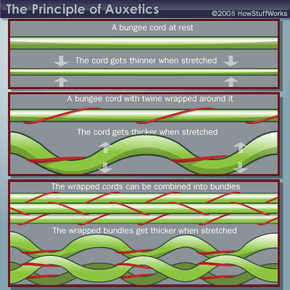Blast-resistant Technology of the Future
There are several new and emerging technologies in the explosive ordnance disposal (EOD) field. Let's examine a few of them.
- Shaped plates. The United States Army is conducting tests on advanced body armor it hopes to distribute to soldiers by 2012, if not sooner. These vests utilize six ballistic plates as opposed to the current two. Additionally, the plates are specially shaped -- a design that leaves less unprotected space between plates provides more protection to the spine [source: Schogol].
- Zetix. Zetix is a material manufactured by the company Auxetics Technologies, Ltd. It actually increases in size as it's stretched out. Picture a length of bungee cord. If you stretch it out, it gets thinner. However, if you wrap a piece of twine around the bungee cord and draw the twine taut, the weave effectively becomes thicker. This is the idea behind auxetics. When these auxetic fiberwraps are bundled together, the bundles also get thicker when stretched out. Such a fabric could be used in blast resistance in many different capacities. If it were used to construct a blast curtain, the helix-shaped structures could be constructed of steel, titanium or carbon fiber. It could potentially allow the force of the blast to pass through the fabric while the fabric itself expands, preventing tears in the blast curtain and to more effectively protect against fragmentation.
- Liquid armor. Liquid body armor is not actually liquid -- it consists of Kevlar plates that have been dipped in a sheer thickening liquid. When force is applied to this substance, it hardens and then liquefies again within a few fractions of a second. When Kevlar has been soaked in this substance, it becomes many times more powerful.
- Nanotubes. Carbon can be bonded in different ways that create entirely new properties. Nanotubes are seamless, cylindrical tubes of carbon molecules that can be as small as one-billionth of a meter wide -- yet up to 60 times stronger than steel. Cloth woven from nanotubes may provide for incredibly efficient body armor -- more resistant to projectiles than steel, yet light enough to provide protection for the entire body [source: Neff].
For more information on bomb, blast-resistant technology and other related information, visit the links below.
Advertisement
Related HowStuffWorks Articles
More Great Links
Sources
- American Fiber Manufacturers Association (AFMA). http://www.fibersource.com/f-tutor/aramid.htm
- American Forces Press Service. "The Bomb Suit's Always Been a Matter of Trust." 25 May 2001. http://www.defenselink.mil/news/newsarticle.aspx?id=45831
- Auxetix Technology Ltd. http://www.auxetix.com/
- BBC. "Anti-mine boots under trial." 9 March 2000. http://news.bbc.co.uk/1/hi/sci/tech/671647.stm
- Davis, Timothy E., and Lee, Catherine Y. "Asymmetric War (Terrorism) and the Epidemiology of Blast Trauma." http://www.gnyha.org/65/File.aspx
- Glass fragment mitigation study performed by Safetydrape using Anti-Terrorism (AT) Assessor software developed by Applied Research Associates. http://www.safetydrape.com/gsa_compliance.php
- Glasser, Ronald. "A shockwave of brain injuries." Washington Post. 8 April 2007. http://www.washingtonpost.com/wp-dyn/content/article/2007/04/06/AR2007040601821 _pf.html
- Inter-American Security Products. http://www.interamer.com/eod-suit.htm
- Neff, Todd. "Portraits in carbon: forget oxygen--carbon may be the most important element on the planet." World Watch. 1 January 2007. http://www.thefreelibrary.com/Portraits+in+carbon:+forget+oxygen--carbon+may+be+the+most+important...-a0157036921
- Paxcon company information. http://www.paxcon.com
- Schogol, Jeff. "Marines downrange to get new body armor in '07." Stars and Stripes. 22 October 2006. http://www.stripes.com/article.asp?section=104&article=39967&archive=true
- Settles, Gary S. "High-speed Imaging of Shock Waves, Explosions and Gunshots" American Scientist. http://www.americanscientist.org/template/AssetDetail/assetid/48547/page/1
- Skews, Beric W. and Bugarin, Sinisa.
- "Blast Pressure Amplification due to Textile Coverings." Textile Research Journal, April 2006. http://findarticles.com/p/articles/mi_qa4025/is_200604/ai_n17172922
- Sofge, Eric. "Bomb-Resistant Buildings: Engineering Reinforcements" Popular Mechanics, Feb. 2007. http://www.popularmechanics.com/technology/military_law/4211265.html
- Suh, Minah, PhD. "New Ways to Diagnose and Assess Attentional and Cognitive Deficits Following Blast Injury." Also authored by Sarkar, Ranjeeta; Kolster, Rachel; Drexel, Pamela; Ghajar, Jamshid, MD, PhDhttp://www.blastinjuryinstitute.org/rehabilitation/Attentional_and_Cognitive_Deficits
- Teo, Ken, Ph.D., lecturer at the University of Cambridge, Dept. of Engineering. http://kennano.com
